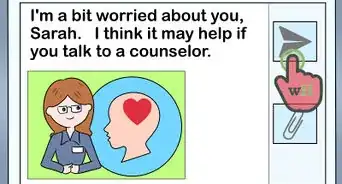This article was co-authored by Liana Georgoulis, PsyD. Dr. Liana Georgoulis is a Licensed Clinical Psychologist with over 10 years of experience, and is now the Clinical Director at Coast Psychological Services in Los Angeles, California. She received her Doctor of Psychology from Pepperdine University in 2009. Her practice provides cognitive behavioral therapy and other evidence-based therapies for adolescents, adults, and couples.
There are 8 references cited in this article, which can be found at the bottom of the page.
wikiHow marks an article as reader-approved once it receives enough positive feedback. In this case, several readers have written to tell us that this article was helpful to them, earning it our reader-approved status.
This article has been viewed 411,746 times.
Validating feelings involves recognizing someone's feelings and acknowledging them as important. In any healthy relationship, it's important to validate someone's feelings when they're upset. Start by listening and responding in simple terms. From there, try to empathize as much as you can. Remember, you don't have to agree with someone's feelings or choices to acknowledge that their emotions are valid.
Steps
Listening and Responding
-
1Give verbal responses to show you're listening. Validation starts with basic listening, while arguing and hurting someone often starts with not being an active listener. It's important to give brief verbal responses to show someone you hear them. Say things like, "Okay", "Uh-huh", and "I see" while the person is talking so they feel heard.
- Try not to interrupt and not to get distracted by your own thoughts (losing focus as a result).
-
2Use body language to show that you're listening. Look at them, and turn your head or entire body towards them while they speak. You may want to stop whatever else you are doing. Show them that you are attentive, present, and engaged.
- If you are doing something else while you listen (e.g., folding laundry or cooking), then look periodically at the person and use other cues to show you're paying attention. Making eye contact is a great way to do this.
- If your body language is affected by a disability, you can still show that you are listening. Try accommodating your needs (e.g., fidgeting with one hand while looking at their chin) or explaining outright that your body language is different, but you are still listening.
Advertisement -
3Stay present. The most basic form of validation is to stay with them, even when their feelings are difficult or unpleasant. Put aside your own discomfort and focus entirely on being there for them. Here are some ways to show you are listening:
- Holding their hand
- Looking directly at them
- Sitting with them or rubbing their back
- Saying "I'm here"
-
4Respond to their general mood and energy level. If someone is excited, let yourself get happy or excited too. If they're sad, be sympathetic. If they're nervous, be comforting and understanding. Mirroring their energy level, and responding to their mood, helps them feel understood.
- For example, if your best friend is very excited about his first date with someone new, he might appreciate you getting excited with him or showing happiness. On the other hand, if he's tentative about it, then you getting too excited might make him feel smothered. It's important to get a good read on how energetic or enthusiastic a person is.
-
5Ask clarifying questions. When a person finishes expressing themselves, ask questions to clarify. This allows someone to elaborate on their feelings and thoughts in a fashion so they feel completely heard.
- For example, say something like, "So, how did that make you feel?" or "What do you think about that?"
-
6Repeat their words back to them. After someone is done expressing their thoughts and feelings, summarize what you heard and repeat it back. It may feel a little silly, but this validates their thoughts by acknowledging you heard and understood them. Try things like:
- "So you're frustrated that the professor gave you so little warning."
- "Wow, you seem really excited!"
- "That must have been hard."
- "Tell me if I've got this straight. You felt hurt when my brother mimicked your disability accent, and I didn't say anything?"
-
7Strive to talk less and listen more. You may have a lot of things to say about someone's thoughts and feelings. Even if your insights are helpful, when someone is first expressing themselves, you should strive to primarily listen. Avoid interrupting or interjecting until someone stops talking.
- Avoid advising at this point, because it may make the person feel like your response is superficial or that you aren't acknowledging their feelings. Instead, focus on just listening and being there for them.[1] They may experience their own revelations about the situation just from you being there to listen.
Empathizing with the Person
-
1Help them elaborate on their feelings. After someone has expressed themselves, see if you can help them elaborate a bit about what they're feeling and why. For example, you could say something like, "I imagine you're feeling pretty hurt?" This will show the person their feelings matter to you and you're trying to understand them.[2]
- If your guess is accurate, they'll likely say "yes, and..." and elaborate on their feelings. If your guess is wrong, they'll likely say "no, actually..." and explain how they truly feel. Either way, you're allowing them to elaborate and process things.
-
2Recall a similar experience you've had. If possible, show the person you understand by relating a similar experience. Then circle back to how you felt, and how their feelings are understandable. This can help them feel validated.[3]
- For example, if a friend didn't get invited to his sisters' vacation, you could say, "Yes, being left out is really hard. My brother and cousin do a camping trip every year, and I'm never invited. It makes me disappointed and sad that I'm left out of the loop. I totally get why you feel down about not being invited to your sisters' thing. It's not fun to be left out."
-
3Normalize their reaction. If you haven't had a similar experience, you can still help validate the person's feelings. You can say something like, "I think most people in that situation would feel that way." This shows you think their reactions are reasonable and they have the right to be experiencing the emotions they're experiencing. Try some of the following:[4]
- "It's okay to be squeamish about your flu shot. Nobody likes those."
- "Of course you're worried about asking your boss for a promotion. This sort of thing is scary for literally everyone."
- "Well, no wonder you don't feel like going out today."
-
4Acknowledge their personal history. You can also help by acknowledging how the person's history affects their emotions. This can be especially helpful if someone is worried they're being irrational or unreasonable. While the person may be reacting in an over-the-top way, you should help them understand they're still allowed to feel their feelings. Try things like the following:[5]
- "Given how Amy treated you, I totally understand why you'd want to take a break from dating. That's a lot to recover from."
- "After that last roller coaster ride, I can see why you'd be hesitant about this one. Want to ride the merry-go-round instead?"
- "Given you got bit by a dog last year, I can see why you're neighbor's new dog might make you nervous."
Avoiding Non-Validating Responses
-
1Do not correct someone's thoughts. Never attempt to correct someone's thoughts or feelings, especially when they are upset. If someone is being irrational, you may be inclined to try to talk them out of it. However, this can come off as negating the person's feelings.[6]
- For example, don't say, "That's not worth getting angry about." It's okay if you disagree with someone's response, but validating is not agreeing. It's simply acknowledging someone's feelings. Instead, you could say something like, "I understand why that would make you angry" or "You sound pretty mad."
-
2Skip the unsolicited advice. Many times, when people tell you about a problem, they just want to be heard. Before opening your mouth to say "just ignore them" or "look on the bright side," stop. Listen more closely to what they are saying, and focus on sympathizing first. They need to process their emotions first.
- If you want to help, first listen. Give them a chance to let it all out and process their feelings. After that, ask if and how you can help.[7]
- If you're unsure, try asking "Are you coming to me for advice, or would you just like to vent?"
-
3Do your best to choose the right form of validation. Remember, you can't always validate in every possible way. Choose the best option for validation. If you're unable to empathize personally, for example, don't try to make comparisons. Instead, offer more general forms of validation.
- Don't minimize the uniqueness of what they're going through. For example, if your friend is confiding in you about his suspected ADHD, don't tell him "everyone gets disorganized sometimes." Or if someone talks about a mean boyfriend, don't say "all guys can be insensitive." If they think their experience is unusual, respect that feeling.
- Don't pretend you know what something is like if you don't. For example, say a friend is stressed due to a divorce. Don't try to empathize directly if you've never been divorced by bringing up a breakup you had. Instead, validate using more general terms. For example, "It's completely understandable you feel that way. Divorce is really tough on most people."
-
4Avoid blame. Never blame someone for their feelings, especially when they're very upset. Blaming someone comes off as you telling them their feelings are not valid. Avoid types of responses such as these:[8]
- "Whining about it isn't going to make it any better. Man up and deal with it."
- "You're overreacting."
- "So you decided to be mad at your best friend. How's that working for you?"
- "Well, maybe he wouldn't have treated you that way if you hadn't been wearing such a short skirt."
-
5Don't try to "hoover" their feelings. Hoovering means vacuuming up any unpleasant feelings and pretending they aren't there. Examples include: [9]
- "Oh, it's not so bad."
- "It's not a big deal."
- "Let's stay positive."
- "It'll all work out in the end! Don't worry."
- "Just toughen up."
- "Look on the bright side."
-
6Don't try to fix their feelings. Sometimes people try to make their loved ones stop hurting simply because they don't want them to be upset. While well-intended, it usually doesn't help them feel better long-term, and they may feel like it is their fault for still being unhappy after your efforts.[10]
- If you want to help, try listening to the whole story and validating their feelings along the way. Then ask how you can help or offer to brainstorm solutions.
- If they are open to having you help brainstorm, make sure that you aren't telling them what to do. For example, instead of saying "You should let go of him," try saying "Personally, I try to let go of people who don't want to be in my life, and focus on those who matter." This lets them decide whether they want to do it your way or not.
Conversation Help
Expert Q&A
-
QuestionWhat is emotional validation?
 Trudi Griffin, LPC, MSTrudi Griffin is a Licensed Professional Counselor in Wisconsin specializing in Addictions and Mental Health. She provides therapy to people who struggle with addictions, mental health, and trauma in community health settings and private practice. She received her MS in Clinical Mental Health Counseling from Marquette University in 2011.
Trudi Griffin, LPC, MSTrudi Griffin is a Licensed Professional Counselor in Wisconsin specializing in Addictions and Mental Health. She provides therapy to people who struggle with addictions, mental health, and trauma in community health settings and private practice. She received her MS in Clinical Mental Health Counseling from Marquette University in 2011.
Professional Counselor Emotional validation is acknowledging and accepting emotions for what they are, understanding they occur in response to something and need to be expressed in healthy ways without judgment.
Emotional validation is acknowledging and accepting emotions for what they are, understanding they occur in response to something and need to be expressed in healthy ways without judgment. -
QuestionWhat does it mean to validate yourself?
 Trudi Griffin, LPC, MSTrudi Griffin is a Licensed Professional Counselor in Wisconsin specializing in Addictions and Mental Health. She provides therapy to people who struggle with addictions, mental health, and trauma in community health settings and private practice. She received her MS in Clinical Mental Health Counseling from Marquette University in 2011.
Trudi Griffin, LPC, MSTrudi Griffin is a Licensed Professional Counselor in Wisconsin specializing in Addictions and Mental Health. She provides therapy to people who struggle with addictions, mental health, and trauma in community health settings and private practice. She received her MS in Clinical Mental Health Counseling from Marquette University in 2011.
Professional Counselor To acknowledge and accept your thoughts, feelings, ideas, and experiences without judgment.
To acknowledge and accept your thoughts, feelings, ideas, and experiences without judgment. -
QuestionWhat does it mean to validate my feelings?
 Trudi Griffin, LPC, MSTrudi Griffin is a Licensed Professional Counselor in Wisconsin specializing in Addictions and Mental Health. She provides therapy to people who struggle with addictions, mental health, and trauma in community health settings and private practice. She received her MS in Clinical Mental Health Counseling from Marquette University in 2011.
Trudi Griffin, LPC, MSTrudi Griffin is a Licensed Professional Counselor in Wisconsin specializing in Addictions and Mental Health. She provides therapy to people who struggle with addictions, mental health, and trauma in community health settings and private practice. She received her MS in Clinical Mental Health Counseling from Marquette University in 2011.
Professional Counselor Validating your feelings mean you recognize that you have feelings, that your feelings are in response to something and that is okay. Then, you allow yourself to feel those feelings without judgment.
Validating your feelings mean you recognize that you have feelings, that your feelings are in response to something and that is okay. Then, you allow yourself to feel those feelings without judgment.
References
- ↑ https://students.ubc.ca/ubclife/emotional-intelligence-101-empathetic-responses
- ↑ https://www.psychologytoday.com/blog/pieces-mind/201204/understanding-validation-way-communicate-acceptance
- ↑ https://www.psychologytoday.com/blog/pieces-mind/201204/understanding-validation-way-communicate-acceptance
- ↑ https://eoc.unc.edu/normalizefeelings/
- ↑ https://psychcentral.com/health/reasons-you-and-others-invalidate-your-emotional-experience
- ↑ https://blogs.psychcentral.com/emotionally-sensitive/2012/02/reasons-you-and-others-invalidate-your-emotional-experience/
- ↑ https://www.hprc-online.org/social-fitness/relationship-building/validation-show-youre-listening-even-if-you-disagree
- ↑ https://blogs.psychcentral.com/emotionally-sensitive/2012/02/reasons-you-and-others-invalidate-your-emotional-experience/
- ↑ https://www.educationtoday.com.au/news-detail/Emotional-validation-is-essential-for-students-5111
About This Article
To validate someone’s feelings, start by listening to them. Make eye contact and put away any distractions to show them that they have your full attention. As they talk, ask clarifying questions or try rephrasing what they say in your own words to make sure that you really understand what they’re trying to say. You can also try asking questions to encourage them to talk and open up more about their feelings. For instance, say something like, “Wow, that must have been really tough. How are you feeling about what happened?” As they’re speaking, do your best to empathize with them and acknowledge their emotions. Think about similar experiences you’ve had and how they made you feel. Try saying things like, “I can totally understand why you’d feel hurt after something like that,” or “Yeah, I remember how scared I was the first time I had to give a speech.” It’s also okay to let them know if you can’t quite understand what they’re going through. Say something like, “I’ve never had an experience like that, I can’t imagine how hard it must be.” Even if you don’t agree with their reaction to the situation, don’t try to correct their thoughts or feelings, blame them for what they’re going through, or tell them they have no reason to feel that way. Instead, ask them if there’s any way you can help—whether it’s offering advice, brainstorming solutions, or just listening to them vent. For more advice from our co-author, like how to avoid saying things that ignore their unpleasant feelings, read on.





























-Step-11.webp)



















































